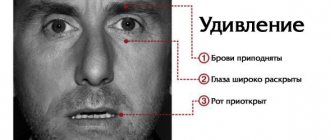Emotional and volitional mental processes
5.1. Emotional Processes
Emotional Process
– the mental process of reflecting in consciousness the subjective meaning of objects and situations (in the form of experiences), influencing the perception, behavior, thinking, motivation, and activity of the individual. Emotional processes are a general term denoting the subjective conscious experience characterized by and associated with the psychophysiological and biological reactions and mental states of the body.
Emotional intellect
(eng. emotional intelligence) - a type of intelligence defined as the ability to correctly and appropriately perceive, evaluate and express emotions, use emotions to facilitate thought processes, understand and analyze emotions, effectively use emotional knowledge, manage your emotions while simultaneously promoting emotional and intellectual development.
Classification of emotional processes
according to their psychological characteristics and patterns of progression:
- affects
(English affect, from Latin affectus - emotional excitement) - short-term intense emotional processes, reflecting a subjective assessment of the situation at an unconscious level, manifested in pronounced motor reactions and changes in the functioning of internal organs and systems of the body; - emotions
(English emotion) – emotional processes reflecting a subjective assessment of the situation at a conscious level
,
which, in comparison with affects, are longer and less intense; - feelings
(English feeling) – a subjective representation of emotions belonging to the individual who experiences them; - moods
are diffuse affective states characterized, in comparison with emotions, by longer duration and lower intensity.
Passion
(English passion, from Greek suffer) is a term used to describe intense emotions, strong feelings and desires. In strength, passion is comparable to affect, and in duration - with feelings.
Physiological basis
emotional processes – restructuring of the internal environment of the body for the purpose of adaptation, carried out under the control of specialized structures of the brain. The leading role in emotional processes is played by the cerebral cortex and the centers of the autonomic nervous system located in the subcortical regions of the brain.
The fibers of the autonomic nervous system mediate the work of smooth muscles and endocrine glands, which synthesize and release hormones into the bloodstream that affect blood pressure, pulse, respiratory rate, blood glucose levels, etc.
In a normal state, the cerebral cortex has an inhibitory effect on the centers of the autonomic nervous system, and external manifestations of emotions and feelings are insignificant. When the cerebral cortex transitions to a state of excessive excitation, the centers of the autonomic nervous system are also overexcited, which leads to vivid emotional manifestations.
Rice.
5.1. Classification of emotional mental processes
Affects
The term affect refers to instinctive reactions to external stimuli that occur before the typical cognitive processes necessary to form more complex emotions. Affect is the most intense form of emotional experience. Most often, strong affect occurs in extreme situations, disrupting the normal functioning of perception and thinking. Affective reactions can occur involuntarily, without intentional perception and cognitive processing.
The reaction to stimuli is dominant in lower organisms and primary for humans. In animals, affects are a defensive reaction and are caused by factors directly related to vital biological needs and instincts. The content and nature of affects are significantly influenced by the social environment and relationships with other people.
Distinctive features of affect:
situational, generalized, short-term, high intensity.
Forms of manifestation of affect:
anger, delight, ecstasy, horror, despair, stupor, constraint.
Emotions
Emotion is a complex pattern of changes involving physiological arousal, feelings, cognitive processes and behavioral reactions in response to situations that are perceived by the subject as personally significant.
Emotions often influence mood, temperament, character, motivation and behavior; they occur under the influence of hormones and neurotransmitters such as dopamine, norepinephrine, serotonin, oxytocin and cortisol. Emotions are often the driving force behind positive/negative motivation and are associated with behavioral trends.
Emotions are mental processes and states associated with the instincts, needs and motives of a person/animal, expressed in the form of experiences. Emotions accompany various manifestations of human activity and are the most important mechanism of internal regulation of human activity and behavior. An important aspect of emotion is cognition, in particular the evaluation and interpretation of events. Basic emotions:
anger, disgust, fear, happiness, sadness and surprise (Paul Ekman, []).
Components
of emotions
:
- impressive –
internal manifestations of emotion (for example, increased breathing and heart rate, increased blood pressure); - expressive
- external manifestations of emotions: undifferentiated muscle reactions (trembling, increased tone) and expressive movements of a communicative signaling nature (facial expressions, gestures, posture, voice intonation).
Emotions are not tied to a specific object and arise in relation to the situation as a whole; they can flow intensely and change quickly. Compared to affects, emotions are much longer in time and weaker in strength; some of them may lack an expressive component.
Emotions can reflect the subjective evaluative attitude of not only real, but also virtual situations. The ideational nature of emotions lies in the ability to arise not only in relation to real ones, but also in relation to expected, imaginary situations and events.
Components of emotions:
- cognitive assessment of events and situations.
- physical symptoms are the physiological component of emotional experience;
- action tendencies – a motivational component for preparing and controlling motor reactions;
- expression - facial expressions and voice accompanying the emotion show the reaction and intentions of the actions;
- feelings are the subjective experience of an experienced emotional state.
Psychological theories of emotions:
- Evolutionary Theory of the Origin of Emotions
, by Charles Darwin, “The Expression of the Emotions in Man and Animals,” 1872. Emotions have evolved through natural selection as vital mechanisms for the organism’s adaptation to the external environment. Physiological changes that accompany emotions are rudiments (residual manifestations) of real adaptive reactions of the body. - Rudimentary theory of emotions
, authors Herbert Spencer (1820 - 1903), Théodule Ribot (1839 - 1916) and others. Emotions are the rudiments of affects that accompanied full-fledged biological reactions of the body. Human emotions are biologically derived from the instinctive and affective reactions of animals. - The Structural Theory of Emotions
by James Papertz (1883 – 1958). There is a single system that unites a number of brain structures and forms the brain substrate for emotions - the limbic system. - James-Lange
somatic theory of emotions , authors William James (1842 – 1910), Carl Georg Lange (1834 – 1900). Emotions are secondary to physiological phenomena. The impact of external stimuli on the body causes physiological changes in it, which leads to the emergence of emotions. - Cannon-Bard theory of emotions
, authors Walter Bradford Cannon (1871 – 1945), Philip Bard (1898 – 1977). Emotions are of a sensory nature: in the process of perception, sensory information enters the thalamus, where it is then redistributed: part of the information is transmitted to the cerebral cortex, giving rise to the subjective experience of emotions, and the other part to the hypothalamus, which regulates all functions of the body. - Lindsay-Hebb activation theory
, authors Donald Olding Hebb (1904 – 1985). Emotions are the sensory equivalent of the brain's activating system, capable of activating the cerebral cortex. The activity of the reticular formation of the brain stem, which filters sensory information and transmits it to the limbic system and cerebral cortex, is correlated with the intensity, duration and quality of emotional experience. - Two-factor theory of emotions
, authors Stanley Schechter (1922 - 1997), Jerome Everett Singer (born 1934). Emotion is a combination of two components: quantitative (physiological arousal) and qualitative (cognitive interpretation of arousal). - Biological Theory of Emotions
, by P.K. Anokhin (1898 – 1974). Emotions are a biological product of evolution that implements the mechanism of adaptation of animals to the environment. Negative emotions are caused by the emergence of needs and play a mobilizing role. Satisfaction of needs generates positive emotions. - Need-information theory of emotions
, author P.V.
Simonov (1926 – 2002). The appearance of emotions is caused by a lack/excess of information necessary to satisfy a need. “ Formula of Emotion
”, proposed by P.V.
Simonov: E = P_(Is - In)
, where
E
is an emotion (strength, quality, sign),
P
is a need,
In
is the information necessary to satisfy it,
Is
is the information that the subject has at the time the need arises. - Cognitive dissonance theory
by Leon Festinger (1919 – 1989).
The emergence of negative emotions is caused by cognitive dissonance
(the discrepancy between the expected and the received result), and positive emotions –
by cognitive consonance
(the coincidence of the expected and the actual). - A unified concept of consciousness and emotions
(Yu. I. Aleksandrov []). Consciousness and emotion should not be viewed as separate psychological processes with different neurophysiological mechanisms. In goal-directed behavior, consciousness and emotions perform similar functions, but with different aspects and at different levels. Behavior is both emotional and conscious.
Functions of emotions:
- o reflective-evaluative
– allows you to generally reflect and evaluate the situation at a conscious level; - signaling
- psychophysiological and biological reactions signal the need to mobilize and adapt the body to the external environment; - reinforcing
– emotions contribute to the development of conditioned reflexes and more durable memory; - communicative
– emotional response, including syntony (emotional “consonance”), as well as microexpressions that accompany emotions and are not amenable to conscious control, help improve mutual understanding between participants in a communicative act; - control
– emotions act as a mechanism for internal regulation of activity and behavior; - mobilizing
– physiological changes that accompany emotions mobilize the body in extreme situations; emotions are the stimulants (motives) of an individual’s activity and behavior; - compensatory
- emotions allow you to compensate for the shortcomings of other mental phenomena.
Classification of types of emotions
- Based on the nature of the needs underlying emotions, the following types of emotions are distinguished:
- lower
- emotions associated with the satisfaction of natural (organic) needs (for oxygen, water, food, etc.), inherent in both animals and humans;
higher
– socially conditioned emotions associated with the satisfaction of needs for security, belonging and love, respect, cognitive, aesthetic needs, needs for self-realization and transcendental needs; are unique to humans. - lower
- By valence
(
I'm drowning
) emotions can be
positive
(joy, interest) or
negative
(fear, anger, rage). It is interesting that in humans the number of negative emotions is several times greater than the number of positive ones.Ambivalence
– simultaneous experience of emotions of opposite signs.
- Based on intensity
(
strength
),
strong
and
weak
emotions are distinguished; The stronger the emotion, the more pronounced its impressive and expressive components will be. - By influence on activity
There are different types of emotions:- sthenic
(from ancient Greek strength) - increase the vital activity of the body, mobilize, encourage active activity (joy, enthusiasm, delight, etc.);
asthenic
(from ancient Greek impotence) - oppress, suppress vital processes in the body (horror, sadness, melancholy, depression, etc.). - sthenic
Emotional disorders
The following pathologies of the emotional sphere of personality are distinguished:
- affective excitability
- a tendency to too easily experience strong emotional experiences that do not correspond to the situation that caused them; - affective weakness
– excessive emotional sensitivity to all external stimuli; anger is a type of affective weakness; - affective lethargy
– rigidity, inertia of emotional reactions, combined with a tendency to fixate on negative experiences; may be accompanied by excessive touchiness, pathological resentment; - affective exhaustion is
the short duration of vivid emotional manifestations, which are then replaced by weakness and indifference.
Personality psychology: how feelings and emotions regulate our behavior
Man is a creature that cannot be indifferent to the outside world. Objects around him, events that he witnesses or participates in in life, evoke different feelings and emotions. All feelings express a person’s attitude to what is happening.
news.livedoor.com
Human experiences
The nature of the experience (pleasure or dissatisfaction) determines the state of emotions - positive or negative. Based on their impact on people and their influence on their further behavior, emotions are divided into sthenic and asthenic. The first ones increase a person’s vital activity and activity, while the second ones reduce it. Positive emotions are attributed to the sthenic effect, and negative emotions to both. For example, if a person is frightened, he quickly runs away, but often, due to wild fear, he simply stands still and does not take any decisive action. Many emotions are dependent on each other. And any positive desire or, conversely, negative, causes a number of similar reactions. All this makes life difficult. The harmony inside disappears and a glance at all this can be instantly seen without delving into the details of what happened. Often, one’s own behavior begins to cause unpleasant strange sensations in the individual. Often he begins to delve into himself, think that he has made a terrible mistake, and begins to analyze all his actions. Such a killing state immediately forces you to think differently and edit what you have done.
Personality Emotion Scheme
Congenital spectrums of sensations are divided into the following:
- fun is positivity, hope and energy;
- hunger - all passionate desires (anticipation of love, touch, peace, as well as food and water);
- anger - a state from mild irritation to rage;
- suffering – physical and emotional pain;
- fear - a state from mild anxiety to wild horror;
- sadness - a state from simply depressed or in a bad mood to terrible grief;
- experience is the birth of mistrust, and in the worst case, despair.
There are people who, at the slightest provocation, fall into deep emotions and see hopelessness everywhere, and life suddenly becomes uninteresting for them. Or they generally become indifferent to everything around them, and nothing worries them anymore, it doesn’t evoke absolutely any emotions, mood or enthusiasm.
classpic.ru
Why are we crying
On the one hand, crying is useful. Thus, a person relieves tension. But, with all this, the incorrect functioning of the actions responsible for mood proves that it still plays an important role in our destiny. One of the more studied stages of the disorder is affect, which is short-term, very strong anxiety. These include horror, anxiety, and negative thoughts. These negative disturbances cause disruptions within the body. They have this unpleasant expression: their whole body shakes, and their face becomes either very pale or too red.
In general, crying is a unique ability of the body. When we cry, harmful chemicals are released from the body. And, in general, it becomes much easier for us, and we can even smile in the first seconds after the end of crying. This is how the body shows that it has eliminated strong negativity and is again ready to continue activity. That is, tears are a remedy for stress poison released by the body. We sometimes begin to cry abruptly and involuntarily, and sometimes we force ourselves to do so, realizing that we need to cry - this is our special organism that feels everything. It is interesting that in this human emotion there is a lot that is still unsolved and incomprehensible.
Try to evoke only positive emotions in yourself! They make life better.








